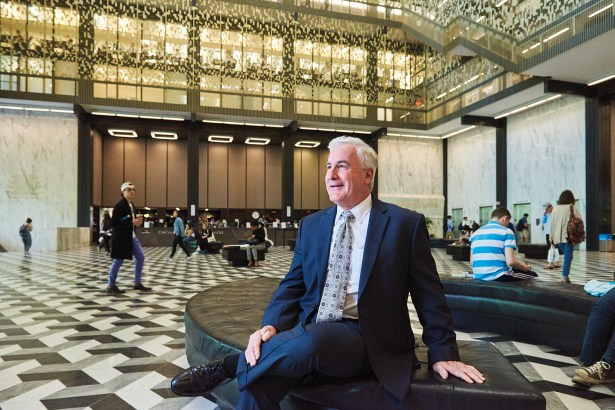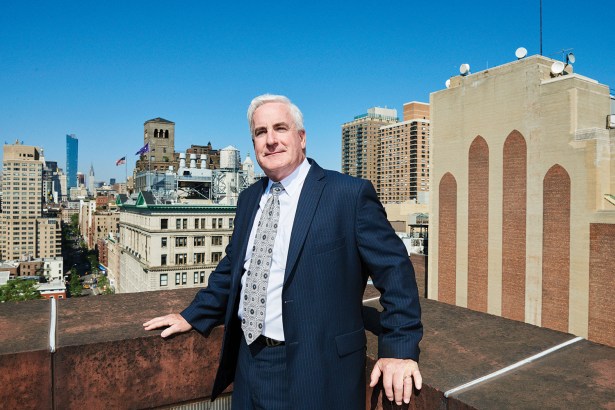NYU’s Martin Dorph Talks About Overseeing the University’s Giant Real Estate Holdings
Martin Dorph oversees the real estate portfolio of a humble school that just happens to sit on about $15 billion worth of assets. Too bad they’re using it for students!
By Sara Pepitone July 24, 2018 11:08 am
reprints
“I wish this university was as wealthy as people think.”
So declared Martin Dorph, the executive vice president at New York University, who oversees the university’s finance, human resources, information technology, investment, campus safety, facilities and construction management offices in New York City and abroad.
Commercial Observer met Dorph in his office on the top floor of Bobst Library at 70 Washington Square South, down a hall shared with NYU’s president and provost, overlooking the park on a day for the brochures: springtime 65 degrees and sunny with just enough breeze to rock the purple and white flags demarking the university’s dormitories and schools.
And from this perch he broke down the school’s $4 billion endowment: about $90,000 per student, of which 5 percent becomes part of his budget. “It’s as if someone said, ‘You’re wealthy, but you have a very big family.’ ” He noted Ivy League institutions have 10 times the endowment and one-quarter the students.
“The bottom line is, there’s not a lot of money to throw around. We always have to be prudent.”
But whether it’s sitting on as much cash as everyone seems to believe, or not, it sits on something else: In New York City, NYU owns or occupies 171 buildings—about 15 million square feet. And they’re in the midst of building a super-project that will add almost 2 million square feet more. (There are also 49 buildings in NYU’s global network, primarily comprising the Abu Dhabi and Shanghai campuses. He travels there four times per year.)
Dorph is the man overseeing this worldwide apparatus.
Dorph’s office is two hours via New Jersey Transit from his home in Washington Crossing, Pa., and unincorporated village is named for the same guy as Washington Square Park, the first president of the United States, AKA commander of the Continental Army, who crossed the Delaware River there with his troops in 1776. It’s fitting for a man whose love of history seems palpable.
Dorph has made the trip most every weekday since 2007, when he left Temple University, where he was CFO and treasurer for 11 years, for a similar role at NYU. “I just stopped commuting south and started commuting north,” the 63-year-old Philadelphian export said. In the morning it’s great, he said. “You can do your emails, read the paper, get ready for the day.”
Dorph has an apartment in Gotham—a unit on campus that he pays rent for like any other NYU tenant—but the framed image over his desk of his pastoral primary property (“green and trees and animals and stuff like that”), and his enthusiasm for weekend lawn-mowing and inexpert golfing (his handicap is higher than the cost per square foot of Manhattan real estate, he joked), make it clear his easy-going personality relies on the balance between the city and the suburbs.
He refers to his wife Carolyn, as “a trooper and a saint.” “I disappear and she takes care of the…” he paused for a moment, searching for the list of things she does, before finishing the thought with: “everything.”
The couple has three children. The oldest is a NYU graduate headed to the University of Pennsylvania School of Veterinary Medicine, the middle is a NYU junior, and the youngest is also heading to Penn in the fall. Dorph earned his M.B.A. and J.D. there, and his parents are also alum.

That is not to say he’s more Quaker than Bobcat (that’s a mascot reference). When Dorph speaks of the foreverness of NYU building purchases and the university’s dedication to Greenwich Village and New York City you get the sense it’s more than just a clever way to market to prospective tuition payers.
“People think of us as the Visigoths coming in to ruin the character of the neighborhood, but part of what makes us successful is the nature of this place we are in, and we have no interest in diminishing the quality of what’s here. It’s the exact opposite, in fact,” he said. “I know we’re big, and we sometimes do stuff that people don’t always like, but we highly prize the neighborhood and we highly prize the buildings that we have in the neighborhood.”
This respect for legacy, surroundings and property, is part of the reason, in Dorph and NYU’s thinking, it’s not as rich as everybody believes.
When it comes to the real estate portfolio, Dorph said, though an incredible source of wealth, NYU does not monetize it because it’s used, and there are no plans to sell. He estimates the book value of the holdings to be $4 to $5 billion, and the market value to be $15 billion or more. But, he added, those figures are meaningless, unless relying on a credit rating agency. “The strategy isn’t about taking the real estate and monetizing it. It’s to use it for the students, faculty and research. That’s what it’s there for. It’s an entirely different dynamic in terms of the way we look at real estate, the way we think about our buildings.”
Which doesn’t mean that NYU isn’t an aggressive real estate player. One advantage the school has, he said, is not being leveraged like developers can be, so when an opportunity arises, they have the capacity to act on it. “We’ve had situations where we’ve been able to walk in and say we are a cash buyer with no financing contingency, and have that make a difference.” Not that he can talk about any such recent transactions which are not public (more chuckling).
The last building Dorph didn’t sell was 404 Lafayette Street and 708 Broadway, purchased together in 2014 for $157 million; 404 Lafayette is a big square and 708 Broadway is narrow and long, 20 feet by something like 150 feet, Dorph said. They struggled to figure out what to put in 708 Broadway so had an idea to sell and use the proceeds to renovate 404 Lafayette. “They” (he says “We”), means Dorph, NYU’s president, provost, board of trustees, real estate committee, facilities team, design team and the dean of the College of Global Public Health. Two years of discussion. Never a single-person decision. Refitting at both properties (see above) is in progress now.
As courtly and benevolent as Dorph seems, not everybody in Greenwich Village views the school through such a benign light.
According to Andrew Berman, the executive director of the Greenwich Village Society for Historic Preservation, who has represented the neighborhood for 16 years at community boards and meetings, the school’s ever-expanding presence is an ongoing source of controversy and contention in the Village. “We all value NYU being part of the community,” said Berman. The concern is largely about the school and its campus taking over, making the entire Village feel like NYU, instead of NYU being an element within. “We want it to remain an ingredient of the neighborhood, growing in sync.”
Dorph said refitting—not expanding—is most of what he and his six teams do, besides strategizing, planning, changing polices and processes, creating budgets, managing risks and preparing for emergencies. He pulled out a double-sided, 11-by-17-inch spreadsheet deemed “a little project list.” Green highlighting is good, yellow is bad, red is ‘I’m in big trouble.’ It’s mostly green, which he accredits to his management staff, like David Soles, who runs the office that implements NYU’s real estate transactions.
James Kuhn, the president of Newmark (NMRK) Knight Frank, has worked with NYU as a consultant for 15 years, helping to acquire real estate, and build and buy dormitories and academic buildings such as 20 Astor Place, 708 Broadway and 120 East 12th Street. “Working with Marty and [NYU Associate Vice President for Real Estate] David Soles has been a pleasure,” Kuhn said. “They are smart, move fast when necessary, cautionary when apparent, and treat all their clients with respect.”
That appears to be Dorph’s natural state of being. He’s the kind of guy who tries to walk outside for lunch every day, taking a breather, hitting food trucks and local delis for turkey-coleslaw-Russian on rye (he worked in the deli his dad owned in Philly; these New York eateries measure up but can’t beat number one, his dad’s deli). He’s also the kind of guy who takes pleasure in local lore.

Minetta Creek, he said, grinning widely, referring to the water body that, according to Museum of the City of New York and mid-1800s maps in its collection, flowed through Washington Square Park—once a marsh amongst farms—via two forks converging at 11th Street and Fifth Avenue. Building the park involved draining the land and rerouting the waterway into culverts and sewer tunnels. “Any time we do any project, anywhere in this neighborhood, people are convinced it’s over Minetta Creek,” he shook his head in gentle mocking. “If Minetta Creek was nearly as expansive as this fear of Minetta Creek seems to be, it would be Minetta Lake, or Minetta Ocean.” Incidentally, NYU planners do know the current path.
It’s a long time since NYU built its first building in 1835, after purchasing the northeast block of Washington Square East between Washington Place and Waverly Place for $40,000 in 1832 from Samuel Thompson, a builder. Then, in its four-story Gothic Revival—replaced in 1892 by what is now known as the Silver Center of Arts and Science—NYU had more space than necessary so leased the surplus. Now, Dorph said, they are always dealing with crowdedness. He cited data from Sightlines, a higher-education facilities analyst: NYU’s academic square footage per student is 250; its peers, on average, are over 500 (Columbia and Fordham are 350). NYU’s location, location, location is a blessing and a curse. It cannot grow like its peers. But grow it must.
How to increase the square footage of academic spaces, student and faculty housing, and recreational facilities has been in contemplation for decades. Currently NYU calls the initiative to increase space at its core campus, “The Core Plan”.
In 2012 the New York City Council approved, via Uniform Land Use Review Procedure, the development of 1.9 million gross square feet on the two superblocks bounded by West Third and West Houston Streets, and Mercer Street and LaGuardia Place. That’s 1 million above grade. Below grade development includes 585,000 square feet of academic space on the northern superblock, and a sports center that will be part of 181 Mercer Street, formerly Coles gym.
Berman says the rationale for the superblock project—we’re already here; you won’t feel a difference—is “ludicrous.” Referring to the thousands of additional people the building will add to the immediate area, he said, “The Starship Enterprise is not going to beam them to their next location. It will certainly impact the Village.”
In progress now, 181 Mercer Street is NYU’s largest academic facility to be, about 750,000 square feet of classrooms, performing arts spaces, including a theater with fly space (the empty space above a stage for storing and attaching scenery), a gym, and student and faculty housing, designed by Davis Brody Bond and Kieran Timberlake, projected to cost $1.285 billion. “We don’t do a lot of new construction, but I guess when we decide to do new construction, boy do we do some new construction,” Dorph said with a smile.
In 2017, NYU’s financing aggregated $766 million in proceeds to fund construction on key capital projects, as well as refinance prior debt tied to its real estate portfolio.
The East Side health corridor (First Avenue between East 23rd and East 34th Streets) and Downtown Brooklyn (including the Polytechnic Institute of NYU) are in consideration for future construction. Governors Island is also of interest, Dorph said, but not part of the anticipated planning for meeting NYU’s space needs, once projected to be 6 million square feet, a number Dorph said is not a requirement. Either way, slow, thoughtful and careful is the building strategy. “We really do try to create quality spaces for faculty, for our students, for our community,” Dorph said. “It’s not always easy to see from the street. It’s a constant process.”
Recently Dorph asked his facilities team to show him the “very worst spaces” NYU owns. He was surprised and gratified by how “not horrible” they were. Needs improvement, yes. And, he smiled, “There were a couple bathrooms that neither you nor I would particularly want to use.”
It’s easy to join Dorph in laughter and to believe him when he states, “We really do take care of our buildings. We are proud to be part of the neighborhood.”
Take a walk around Washington Square Park and see for yourself.


